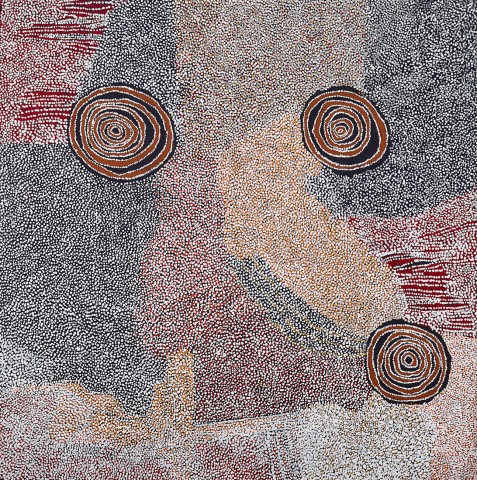ROCKHOLES NEAR THE OLGAS, 2008
BILL WHISKEY TJAPALTJARRI
synthetic polymer paint on linen
182.0 x 183.0 cm
bears inscription verso: Watiyawanu cat. AEBWT77-08479PG
Watiyawanu Artists of Amunturrungu, Mt Liebig, Northern Territory
Art Equity, Sydney
Private collection, Brisbane
At the venerable age of 85 Bill Whiskey Tjapaltjarri (c.1920 – 2008) began painting at the Watiyawanu Artists of Amunturrngu Cooperative and almost immediately rose to national prominence as a Western Desert artist with a singular and powerful voice. Over a four-year period, he produced canvases of often monumental scale laden with almost microscopic subtlety and shimmering pointillist effects. In effect he seamlessly wove together an epic impulse (one intent on amplification of the totemic significance of his birthplace country) and a miniaturist’s eye for detail as befits a traditional nomadic man attuned to the import of the slightest dislodgement of a single pebble in a dry creek bed or the tremble in a tussock of grass. It is said that Bill Whiskey did not see a white person until a teenager.
In later years, based at Mount Liebig near Papunya, Whiskey had witnessed the evolution of the Western Desert Art Movement and recognizing the importance of painting as a medium for preserving and broadcasting cultural identity heritage had one day decided to simply pick up the brush! His wife, Colleen Nampitjinpa was also already well established as an artist.
Though such background might go some way to explain the instant confidence with which he approached a rolled-out canvas it does not explain that inimitable quality that allows us to identify a Bill Whiskey painting at a glance. There is a luminous buoyancy to his often-giant roundels (concentric circles) representing key totem sites connected to the Cockatoo Dreaming; they seem to somehow detach from the surface of the painting and hover. Likewise, as can also be seen in the present work, there is an oscillating quality to the over-all structure of the image. It seems to contract to an invisible central point and at the same time expand pervasively outwards. In this way it playfully acknowledges the inevitable four-sided constraint imposed by the physical medium of “Western” painting and defies it. The result is an endlessly stimulating kinetic dynamism, one richly and densely reinforced by the same oscillating momentum created by the swathes and colour-field boundaries of swarming “dots” that might be said to perform in the background – but only in a certain sense, as this is far from the illustrative terrain of the picturesque landscape belonging to Western Cartesian culture.
“Dots” is itself a tricky word in these circumstances as they variously represent fields of flowers, outcrops of brilliantly sparkling quartz shards, sudden rocky outcrops, fringed surges of grassland, beds of brightly coloured sand, etc. If one looks carefully and deeply into this swarming activity, one can even discern in some passages the tracery of significant walking tracks carefully mapped and then obscured beneath dots now performing as camouflaging veil, just as did Emily Kngwarreye – in her case to disguise sacred body painting designs.
With its tender pastel palette and constantly circulating trio of bold icons this is an impressive example of the artist’s work. Dated 2008, it belongs to the last phase of his all-too short career.
ROSS MOORE
